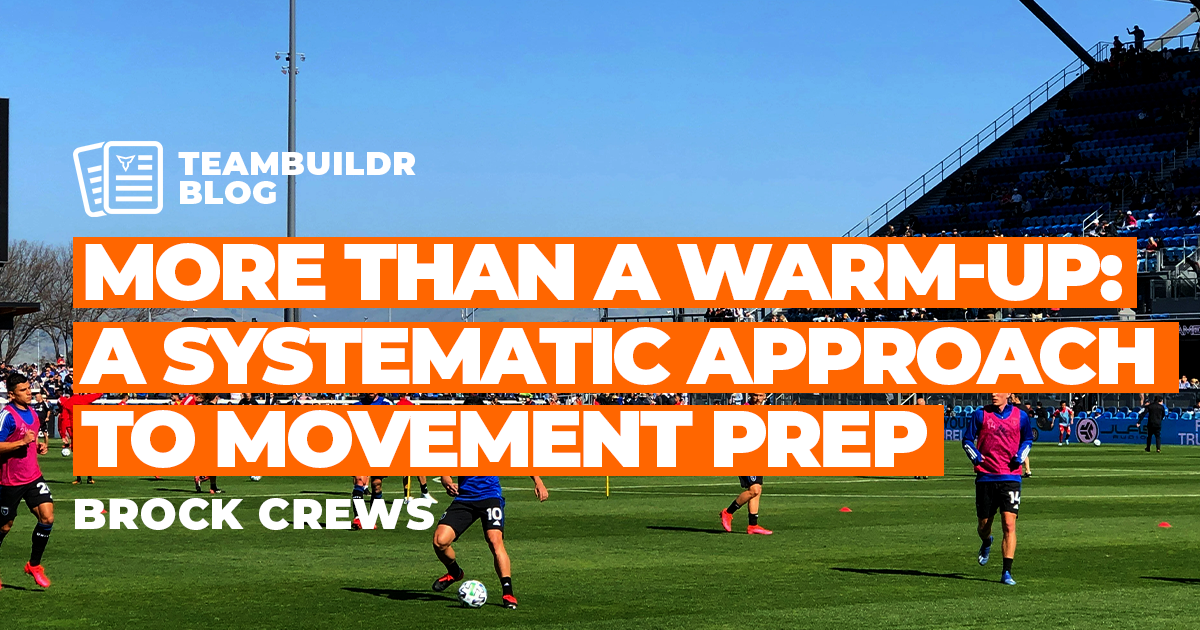Implementing the RAMP Protocol in Warm-Up Routines
To maximize our athlete’s ability to perform at their peak, we must provide them with a quality warm-up before lifts, practices, or games. A good warm-up allows for raising the core body temperature, warming of the muscles and connective tissue, activation and potentiation of nervous function, and mobilization of joints. As a coach, it is important to have a structured warm-up for your athletes that leaves them prepared for the upcoming task. Using the RAMP protocol can help serve as a guide for developing your warm-up. RAMP stands for Raise, where we start by raising the body, temperature, heart and respiratory rate, blood flow, and synovial fluid viscosity. Activate and Mobilize focus on targeting key muscles or movement patterns needed for the upcoming task.
Finally, Potentiate involves increasing neuromuscular activity to potentiate PAP. According to a systematic review by Silva et. al., the research shows that a good warm-up should be between 40%-60% maximum rate of oxygen uptake. It should only be 5-10 minutes with no evidence that a longer warm-up was better.
Raise
As mentioned in the introduction, the initial goal of the warm-up should be to raise the body temperature, heart and respiratory rates, blood flow, and synovial fluid viscosity. Raising the body temperature can change the way our extracellular matrix behaves, allowing for less friction between the connective tissues and muscles, allowing for more elasticity and shape stability, reducing the chance for injury.
Once the whole body is warmed up, the athlete can elect to do some local self-myofascial release (SMR) including “rub and scrub,” foam rolling or trigger point balls, or vibration guns. This step can be important if the athlete is suffering from a reduced range of motion from their knot or stiffness. Cheatham et. al. conducted a systematic review finding that “SMR using a foam roll for thirty seconds to one minute (2 to 5 sessions) or roller massager for five seconds to two minutes (2 to 5 sessions) may be beneficial for enhancing joint flexibility as a pre-exercise warm-up and cool down due to its short-term benefits”.
Raising heart and respiratory rates before exercise allows our body to adapt to the increased oxygen demand and allows it to begin delivering oxygen to our muscles faster. Additionally, this is why we need to increase our blood flow as well. Finally, increasing synovial fluid viscosity reduces friction within the joints and allows for more ROM. Once we’re warmed up, it is time to kick it into gear.
Activate and Mobilize
It is important to start this section off by noting that static stretching will hinder athletic performance. When activating and mobilizing, we are looking at the specific muscle groups and movement patterns that will be utilized for the upcoming task. This should be a dynamic and/or ballistic style warm-up emphasizing good motor patterns and technique. If done correctly and with intent, this can be additional touchpoints for techniques such as running mechanics and calisthenics.
Movements such as high knees, butt kicks, A/B skips, etc. can serve to reinforce proper frontside mechanics in athletes, and doing them in a warm-up every day provides additional reps that will help them create those motor pathways and make them stick. Additionally, this is where we want to mobilize the major joints we will be using. Ankles, knees, hips, spinal column, and shoulders are all good ones to check off, with sport-specific mobilization following the major joints. This doesn’t have to be anything crazy and can be worked into your dynamic warm-up without additional steps. Now that we’re warmed up, and the muscles and joints are ready to go, we need to prime the nervous system.
Potentiate
Potentiation is a temporary enhancement of muscle contractions or neural responses following specific activities or stimuli, which occurs due to an increased excitation of the neuromuscular system, resulting in improved muscle force production, rate of force development, or movement efficiency.
When potentiating during a warm-up it is important to save it for last and immediately go into your highest neural exercise of the session. In this step, we are trying to increase neuromuscular activity, so we can activate post-activation potentiation (PAP). PAP is a specific form of potentiation where previous muscle contractions or high-intensity exercises induce a short-term improvement in muscle function which occurs due to the residual effects of the prior activity on the neuromuscular system, leading to an increased readiness for subsequent contractions. This can be performed through movements that mimic the upcoming task (i.e. heavier squats ahead before cleans) and can also be useful for contrast training methods.
Priming the nervous system is important for injury prevention, allowing us to ensure all the correct muscles are firing in sequence, before attempting heavier or higher-volume movements.
RAMP Protocol Sample
As mentioned in the introduction, the warm-up should be between 40%-60% maximal oxygen uptake and last between 5-10 minutes. With that in mind, we need to loosely follow the RAMP framework, but we can do a lot with each step. Starting, with a quick jog, jump rope, assault bike, whatever, just get the body moving. Following this, we can get into our dynamic movements such as leg swings, hip/arm circles, etc. From there, we get into our specific movements for the task such as lateral lunges, bodyweight or counterweight squats, push-ups, band face pulls, etc.
Additionally, within this activation and mobilization phase, we can add proprioceptive neuromuscular facilitation (PNF) stretching. This is accomplished with a partner providing a stretch to the end range of the muscle, the athlete resisting into their partner, relaxing, and allowing the muscle to stretch a bit further. Finally, we can potentiate, which can be as simple as explosive MB throws and box jumps, to repeat jumps or bounds. From here, you can start getting into the beginning of the session.
Conclusion
It is important to know your athletes’ abilities, the needs of the sport, and the demands of the coach (usually time restraints) when planning and organizing your warm-up. A good warm-up does not require any equipment or a lot of space or time. More importantly, the warm-up should serve to get the athletes focused and prepared for the lift, practice, or game. Allowing for fun is important since we are trying to loosen the body up, however, there still should be a presence of focus and intent. The warm-up is not just something we have to do beforehand, it can and should be the beginning of the lift, practice, or game, allowing for additional touchpoints and movement quality that will all create a better overall athlete.
References
Subscribe to our blog
Subscribe to receive the latest blog posts to your inbox every week.
Related posts

3 Ways College Strength Coaches Can Play a Role in Recruiting

Systematic Approach to Movement Preparation


